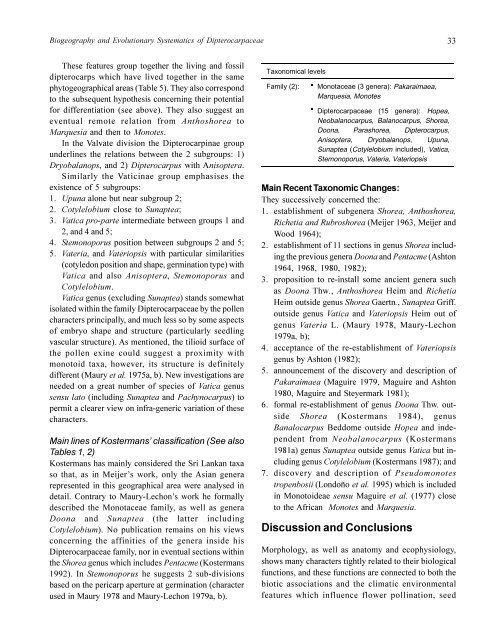A review of dipterocarps - Center for International Forestry Research
A review of dipterocarps - Center for International Forestry Research
A review of dipterocarps - Center for International Forestry Research
Create successful ePaper yourself
Turn your PDF publications into a flip-book with our unique Google optimized e-Paper software.
Biogeography and Evolutionary Systematics <strong>of</strong> Dipterocarpaceae<br />
These features group together the living and fossil<br />
<strong>dipterocarps</strong> which have lived together in the same<br />
phytogeographical areas (Table 5). They also correspond<br />
to the subsequent hypothesis concerning their potential<br />
<strong>for</strong> differentiation (see above). They also suggest an<br />
eventual remote relation from Anthoshorea to<br />
Marquesia and then to Monotes.<br />
In the Valvate division the Dipterocarpinae group<br />
underlines the relations between the 2 subgroups: 1)<br />
Dryobalanops, and 2) Dipterocarpus with Anisoptera.<br />
Similarly the Vaticinae group emphasises the<br />
existence <strong>of</strong> 5 subgroups:<br />
1. Upuna alone but near subgroup 2;<br />
2. Cotylelobium close to Sunaptea;<br />
3. Vatica pro-parte intermediate between groups 1 and<br />
2, and 4 and 5;<br />
4. Stemonoporus position between subgroups 2 and 5;<br />
5. Vateria, and Vateriopsis with particular similarities<br />
(cotyledon position and shape, germination type) with<br />
Vatica and also Anisoptera, Stemonoporus and<br />
Cotylelobium.<br />
Vatica genus (excluding Sunaptea) stands somewhat<br />
isolated within the family Dipterocarpaceae by the pollen<br />
characters principally, and much less so by some aspects<br />
<strong>of</strong> embryo shape and structure (particularly seedling<br />
vascular structure). As mentioned, the tilioid surface <strong>of</strong><br />
the pollen exine could suggest a proximity with<br />
monotoid taxa, however, its structure is definitely<br />
different (Maury et al. 1975a, b). New investigations are<br />
needed on a great number <strong>of</strong> species <strong>of</strong> Vatica genus<br />
sensu lato (including Sunaptea and Pachynocarpus) to<br />
permit a clearer view on infra-generic variation <strong>of</strong> these<br />
characters.<br />
Main lines <strong>of</strong> Kostermans’ classification (See also<br />
Tables 1, 2)<br />
Kostermans has mainly considered the Sri Lankan taxa<br />
so that, as in Meijer’s work, only the Asian genera<br />
represented in this geographical area were analysed in<br />
detail. Contrary to Maury-Lechon’s work he <strong>for</strong>mally<br />
described the Monotaceae family, as well as genera<br />
Doona and Sunaptea (the latter including<br />
Cotylelobium). No publication remains on his views<br />
concerning the affinities <strong>of</strong> the genera inside his<br />
Dipterocarpaceae family, nor in eventual sections within<br />
the Shorea genus which includes Pentacme (Kostermans<br />
1992). In Stemonoporus he suggests 2 sub-divisions<br />
based on the pericarp aperture at germination (character<br />
used in Maury 1978 and Maury-Lechon 1979a, b).<br />
Taxonomical levels<br />
Family (2):<br />
Monotaceae (3 genera): Pakaraimaea,<br />
Marquesia, Monotes<br />
Dipterocarpaceae (15 genera): Hopea,<br />
Neobalanocarpus, Balanocarpus, Shorea,<br />
Doona, Parashorea, Dipterocarpus,<br />
Anisoptera, Dryobalanops, Upuna,<br />
Sunaptea (Cotylelobium included), Vatica,<br />
Stemonoporus, Vateria, Vateriopsis<br />
33<br />
Main Recent Taxonomic Changes:<br />
They successively concerned the:<br />
1. establishment <strong>of</strong> subgenera Shorea, Anthoshorea,<br />
Richetia and Rubroshorea (Meijer 1963, Meijer and<br />
Wood 1964);<br />
2. establishment <strong>of</strong> 11 sections in genus Shorea including<br />
the previous genera Doona and Pentacme (Ashton<br />
1964, 1968, 1980, 1982);<br />
3. proposition to re-install some ancient genera such<br />
as Doona Thw., Anthoshorea Heim and Richetia<br />
Heim outside genus Shorea Gaertn., Sunaptea Griff.<br />
outside genus Vatica and Vateriopsis Heim out <strong>of</strong><br />
genus Vateria L. (Maury 1978, Maury-Lechon<br />
1979a, b);<br />
4. acceptance <strong>of</strong> the re-establishment <strong>of</strong> Vateriopsis<br />
genus by Ashton (1982);<br />
5. announcement <strong>of</strong> the discovery and description <strong>of</strong><br />
Pakaraimaea (Maguire 1979, Maguire and Ashton<br />
1980, Maguire and Steyermark 1981);<br />
6. <strong>for</strong>mal re-establishment <strong>of</strong> genus Doona Thw. outside<br />
Shorea (Kostermans 1984), genus<br />
Banalocarpus Beddome outside Hopea and independent<br />
from Neobalanocarpus (Kostermans<br />
1981a) genus Sunaptea outside genus Vatica but including<br />
genus Cotylelobium (Kostermans 1987); and<br />
7. discovery and description <strong>of</strong> Pseudomonotes<br />
tropenbosii (Londoño et al. 1995) which is included<br />
in Monotoideae sensu Maguire et al. (1977) close<br />
to the African Monotes and Marquesia.<br />
Discussion and Conclusions<br />
Morphology, as well as anatomy and ecophysiology,<br />
shows many characters tightly related to their biological<br />
functions, and these functions are connected to both the<br />
biotic associations and the climatic environmental<br />
features which influence flower pollination, seed

















